Step by Step on The Way of Saint James
From Carrión de los Condes to Terradillos de los Templarios
27 May 2018
Stage 17 – Km. 26
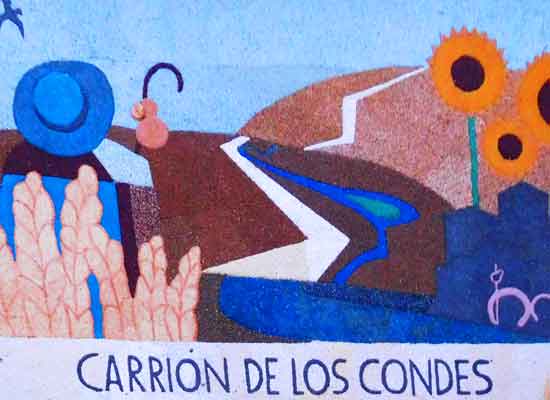
After a night of rest, it seems my legs are in better condition. However, this doesn’t mean the problem is resolved, and it’s possible that severe pain may return during the day, as it did yesterday. I should probably stop for a few days to rest until everything gets back to normal, but for now, I don’t want to consider this option. I press on, hoping not to make things worse. My current treatment includes anti-inflammatory capsules and topical ointments.
– Now, in the morning after waking up, I need to allow at least fifteen minutes to apply the ointment for pain relief on my legs and petroleum jelly on my feet to prevent blisters. –
This morning, I want to start earlier to tackle today’s stage more calmly. These are notoriously the most monotonous kilometres of The Way. After setting off, the first village we encounter is seventeen kilometres away. This stretch of the French Way, besides being boring, can also be quite challenging in summer and generally on sunny days due to the intense heat.
Here, more than in other parts of the “mesetas,” The Way often subjects pilgrims to great suffering because of the scorching sun and the lack of drinking water sources. It’s strongly recommended to stock up on water before setting out.
Today we have breakfast in the room, eating what we bought yesterday.
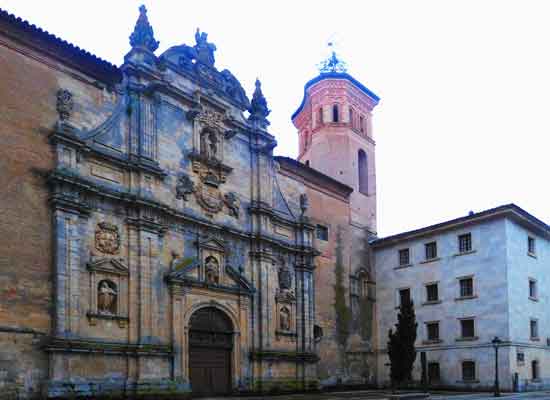
We leave the hostel at 6:20.
Leaving Carrión de los Condes, we cross the puente Mayor. The bridge over the Carrión River was built in Romanesque style and later remodelled several times over the centuries. It is one of the many bridges constructed in the 11th century along the Jacobean route to facilitate the passage of pilgrims and merchants.
Shortly after the bridge, we pass the ancient Benedictine Monastery of San Zoilo, dating back to the 10th century, which has now been partly transformed into a three-star hotel. Walking past, we can see the exterior façade, although the most remarkable aspect of the building is its internal cloister in Plateresque style, enriched with various sculptures.
It’s exactly seven o’clock as the sun rises behind us. After peeking over the horizon, it plays hide and seek between streaks of clouds as it rises higher. The surroundings are bathed in the warm morning colours, hinting that today will be a beautiful day.
– Let’s hope the term “warm” refers only to the landscape’s hues and not to the temperature. –
The road we follow is paved and lined with numerous trees. The truly “killer” section of today’s stage begins after the turn-off to Villotilla. From this point, we leave the asphalt and continue along a dirt track, which follows the Via Aquitana, an ancient Roman road built to connect Bordeaux and Astorga.
The path is straight and stretches through a flat and monotonous landscape that remains unchanged for almost twelve kilometres. Alongside the dominant green of the fields, the yellow of rapeseed and the red of poppies stand out. These delicate flowers crowd the edges of the path and seem to cheer us on as we pass.
– Come on! Come on! You’ll make it!!! –
If they could speak, that’s probably what they’d say.
I could really use some encouragement because, as I walk this endless path through the void, the pain in my shins grows increasingly intense, becoming excruciating. No one can help me, and despite the pain, my only option is to keep pushing forward.
– If I want to reach my destination, I must keep walking. There’s no alternative! –
The positive note is that the temperature is bearable, and there’s none of the heat that usually scorches this land and tests travellers. In fact, I’m still wearing my windbreaker.
In these parts, it’s strongly advised not to draw water from wells or the occasional fountain, as they may be contaminated by runoff from cultivated fields.
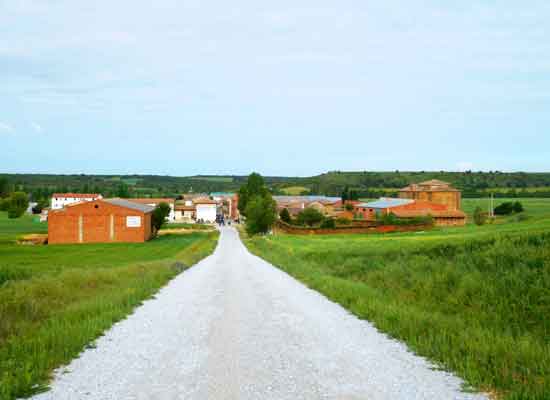
***
It’s been four full hours since I left the hostel this morning, and at last, I see Calzadilla de la Cueza appearing ahead. No, it’s not a mirage but a real vision of the much-anticipated village, which, after seventeen kilometres of walking, will let me rest and recharge.
Despite the path through the fields seeming completely flat, it’s actually a slight incline, and the village lies just beyond a small hill. For this reason, Calzadilla de la Cueza only comes into view a few hundred metres before arrival.
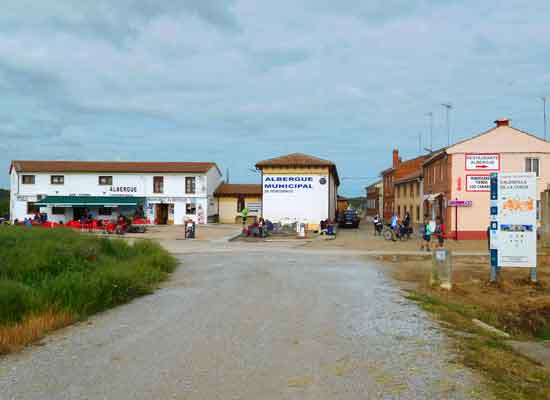
All the pilgrims who have completed the long and exhausting journey are here—at El Camino Bar, right at the village entrance. Its location is perfect since no one arriving wants to take even one more step.
I stop here too, settling into the first free chair I find. I’m quite worn out, not so much from the long walk but from the physical pain gripping my legs. What saddens me most is the thought that abandoning this journey seems to be the only inevitable solution to the problem.
Red chairs and matching tables fill the outdoor area where pilgrims can rest.
As soon as I remove my backpack, I sit down, take off my shoes, and roll up my trousers to my knees. I apply anti-inflammatory ointment to my shins, massaging them gently. Then I have a quick snack.
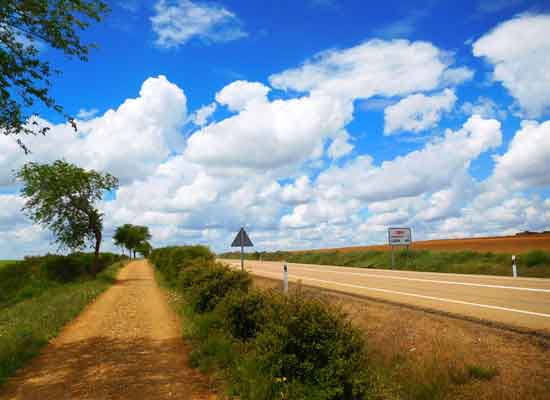
At 11:30, I start walking again, confident that I can manage the remaining nine kilometres to my destination. It feels like the rest has done my body good, reducing the pain to a tolerable level.
Before setting off, as the temperature has risen, I remove a few layers of clothing, leaving only a short-sleeved shirt. The sun, now high in the sky, makes its presence felt, although the heat is still far from the intensity of the summer months.
I have no more news of my friends and continue walking alone. The landscape remains unchanged, the only difference being that the dirt path now runs parallel to the paved road.
Just over an hour has passed since my last break, and as I arrive in Ledigos, I feel the need to stop again and eat something more substantial.
In a bar, I order the usual tortilla, which “me gusta mucho,” accompanied by a fruit juice.
I rest for about half an hour and then resume walking to complete the final three kilometres of today’s journey.
At 14:50, I finally arrive in Terradillos de los Templarios.
In reality, I don’t enter the village itself because the hostel where my friends stopped earlier is located about five hundred metres before the entrance to the town.
Although I’m a little disappointed not to be staying in the centre, I’m also content with this arrangement, as it has shortened my route slightly. Moreover, once again, Rocco kindly reserved a spot for me.
In the room, the bunk above mine is occupied by a young man from Ushuaia, the southernmost city in the world, located in Argentina’s Tierra del Fuego.
Of all the pilgrims I’ve met along The Way of Saint James, he is undoubtedly the one who has travelled the furthest to get here.
The hostel we’re staying at is the Albergue los Templarios. It’s a new, clean, and well-organised structure, and its most valuable feature is the large green space surrounding the building.
I decide to spend the entire afternoon resting and, considering that the village is half a kilometre away, I choose to stay at the hostel and not walk any further until tomorrow morning.
After taking a shower, I make myself comfortable in the sun, stretch out my legs, have a snack, and chat with other pilgrims.
Among them is Giovanna, a young woman from Sassari, who is also struggling with physical ailments.
Her feet are covered in blisters, and a pilgrim from Eastern Europe, who happens to be a nurse, has carefully treated them. She punctured the blisters with great professionalism, applied antibiotic ointment, and covered them with large plasters.
Giovanna, having faced many issues during The Way, has become an expert in managing physical problems. She convinces me to try a medical gel she has already used successfully on herself.
While Rocco and Dante, along with the three friends from Tuscany, go for a walk in the village centre, I stay behind at the hostel.
I use the time to read up on the village in the guidebooks. Since I’m not joining them, this is the only way for me to learn about the place and decide whether I’m missing anything particularly interesting.
The name Terradillos de los Templarios refers to the Knights of the Temple, or Templars, as the village was under the jurisdiction of this order.
The original purpose of the Templars was to protect Christians travelling to Jerusalem during the Middle Ages. As guardians of the holy sites, they extended their protection to the routes of The Way of Saint James as well.
There are several legends associated with this location, including stories about the “golden hen,” which is said to have been buried in the area by the last Templars.
One tale recounts how a priest used to bring a golden egg to Santiago each year until he was asked to bring the hen itself instead.
Apart from these curiosities, skipping a visit to the village doesn’t seem to mean missing out on anything particularly significant.
Around 20:00, we have dinner at the hostel’s restaurant, and by 21:00, we’re already in bed.
– Tomorrow morning, we start early again! –
For my pain, I’ve been advised to take magnesium and potassium. I honestly don’t know why I didn’t think of it myself earlier—taking them as a preventive measure rather than waiting for problems to arise.
Since I don’t have any, I ask Dante to lend me a couple of sachets to start the treatment immediately, as he has a good supply.
– I’m willing to try anything at this point to avoid giving up and to get back in shape as soon as possible. –
| © Aldo Lardizzone 2020 |  |
CREATIVE COMMONS |



